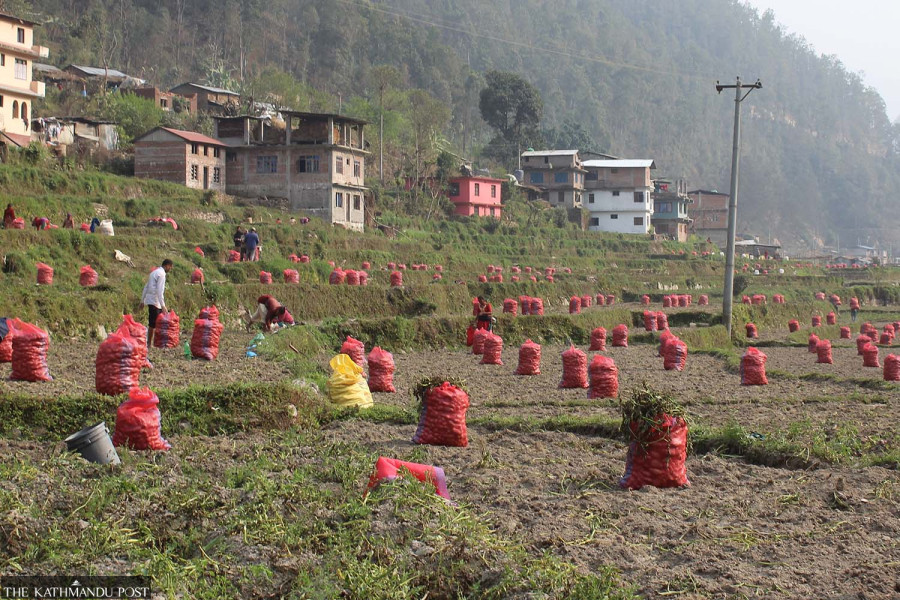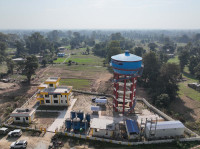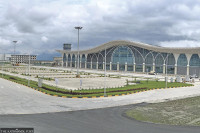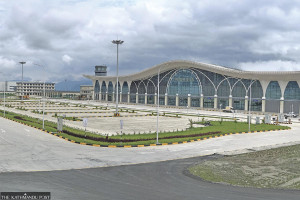Money
Vegetable prices shoot high as festivals eat up supplies
With Dashain nearing, consumers struggle as traders hike prices 137 percent despite normal supply.
Post Report
Vegetable prices, which had started climbing with the onset of the festive season, continued to rise on Sunday as the Sohra Shraddha fortnight kicked in, further boosting demand. Prices have surged by as much as 137.5 percent in just a month.
According to the Kalimati Fruits and Vegetable Market Development Board, the wholesale prices of tomato, potato, onion, carrot, cabbage, cauliflower, radish, cowpea, French bean, sword bean, bitter gourd, smooth gourd, sponge gourd, pumpkin, squash, green leafy vegetables, mushroom, asparagus, broccoli, cucumber, ginger, and green chilli have all gone up.
“Farm production is normal, but the surge in demand due to festivals and rituals has pushed prices up,” said Binay Shrestha, information officer at the Kalimati board.
Vegetable prices in Nepal typically fluctuate due to supply chain disruptions, seasonal shortages, retail markups, middlemen, and heightened demand during festivals. Shrestha said cauliflower prices are expected to rise further during Dashain.
The Sohra Shraddha (or Pitri Paksha) ritual, which lasts 16 days, is a Hindu tradition where families pay homage to deceased ancestors during the waning moon of Ashwin, culminating on the new moon day.
Traders expect vegetable prices to escalate until the festive season ends in October. For consumers, these seasonal hikes have always been painful.
Rajan Kuikel from Teku, who works in a cooperative, spent nearly Rs1,000 on just a few vegetables, including two kilograms of cauliflower at Rs310, along with potatoes, leafy greens, and bitter gourd.
“I have my father’s shraddha on Monday and still need to buy other items. Vegetables alone have cost me dearly,” said Kuikel. “As festivals approach, prices rise daily, making it very difficult to manage within a limited budget.”
According to Nepal Rastra Bank, the annual average inflation stood at 4.06 percent in the last fiscal year, while vegetable inflation jumped to 10.71 percent compared to 8.29 percent a year earlier.
Consumer rights activists accuse traders of exploiting festivals to inflate prices, often by creating artificial shortages and indulging in black marketing under lax government oversight. Despite market anomalies peaking during festive times, authorities have failed to regulate prices effectively.
On Sunday, the Kalimati board recorded 752 tonnes of vegetable arrivals, up from 682 tonnes a month ago.
The wholesale price of bitter gourd shot up 137.5 percent to Rs57 per kg, while retail prices ranged between Rs110 and Rs120 per kg.
Tomato prices also soared. The wholesale price of big Nepali tomatoes rose 19.27 percent to Rs65.20 per kg, while small local tomatoes jumped 79.46 percent to Rs40.20 per kg. Tunnel-farmed small tomatoes increased 73.21 percent to Rs58.20 per kg. Retail prices stood at Rs140–150 per kg for big tomatoes and Rs90–100 per kg for local ones.
Cabbage prices surged the most, with wholesale rates rising 157.73 percent to Rs50 per kg. In retail markets, cabbage cost Rs60–70 per kg.
Cauliflower (local) wholesale prices increased 8.43 percent to Rs90 per kg, while cauliflower from the Tarai climbed 17.31 percent to Rs76.25 per kg. Retail prices stood at Rs140–150 per kg.
White radish prices rose 23.33 percent to Rs46.25 per kg in wholesale markets and were sold at Rs60–70 per kg in retail.
The wholesale price of long cowpea increased 20 percent to Rs90 per kg, while short cowpea rose 15.38 percent to Rs75 per kg.
French bean (local) prices climbed 26.67 percent to Rs95 per kg, while French bean (hybrid) shot up 66.67 percent to Rs95 per kg. In retail, French beans were priced at Rs140–150 per kg.
Smooth gourd prices rose 24.44 percent to Rs56 per kg, retailing at Rs110–120 per kg.
Pumpkin wholesale prices rose 11.11 percent to Rs50 per kg, with retail prices hitting Rs70–80 per kg. Mustard leaf prices jumped 77.27 percent to Rs97.50 per kg.




 8.12°C Kathmandu
8.12°C Kathmandu












%20(1).jpg&w=300&height=200)
